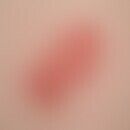Synonym(s)
HistoryThis section has been translated automatically.
Gougerot and Goncea 1915; Fabry J 1917
DefinitionThis section has been translated automatically.
You might also be interested in
EtiopathogenesisThis section has been translated automatically.
Hyperhidrosis, occlusive footwear and poor foot hygiene have a promoting effect. If the interdigital spaces are affected, damp work or flour work must be taken into account. Wearing rings also has a positive effect.
In addition to Candida albicans, Candida guilliermondii and others have been identified as causes of interdigital candidiasis.
LocalizationThis section has been translated automatically.
Especially on the feet, in the toe spaces of the 2nd - 4th digitus. It is not uncommon for the interdigital spaces 3 and/or 4 to be affected (Schlager E et al. 2018).
ClinicThis section has been translated automatically.
Striking is the strong maceration of the horny layer of the affected skin areas. The macerative skin areas peel off in shreds and leave a highly red erosive area.
Complication(s)(associated diseasesThis section has been translated automatically.
General therapyThis section has been translated automatically.
- Informing the patient about the factors that favour this. In case of foot infestation, careful foot hygiene, changing and boiling out the socks daily, open, breathable footwear (e.g. breathable leather or Goretex).
- It is important to disinfect the shoes with disinfectants, e.g. with Sagrotan Spray or Canesten Spray, if necessary buy new shoes.
- Prophylactic wearing of bathing sandals in public swimming pools, saunas and showers.
- In case of hand infestation, clarification and elimination of the cause, e.g. change in washing behaviour or detergents (wet work with alkaline detergents).
External therapyThis section has been translated automatically.
- Dry out the interdigital rooms with linen cloths and dry brushes or foot baths with aqueous antiseptic solutions.
- Antimycotic therapy with azole-containing creams / ointments, e.g. with 1-2% clotrimazole (e.g. Canesten, Canifug), 2% miconazole (e.g. Vobamyk, Daktar, R172 ) or 1% bifonazole (mycospor).
LiteratureThis section has been translated automatically.
- Schlager E et al (2018) Erosio interdigitalis blastomycetica: A review of interdigital candidiasis.
Dermatol Online J 24 (8). - Seebacher C et al (2006) Candidosis of the skin. J Dtsch Dermatol Ges 4: 591-596
Incoming links (2)
Clotrimazole ointment hydrophilic 2% (nrf 11.50.); Miconazole nitrate cream, hydrophilic 2% (nrf 11.79.);Outgoing links (12)
Antiseptic; Bifonazole; Candida albicans; Candida guilliermondii; Candidoses; Clotrimazole; Disinfectants; Erysipelas; Foot infection gram-negative; Hyperhidrosis (overview); ... Show allDisclaimer
Please ask your physician for a reliable diagnosis. This website is only meant as a reference.





